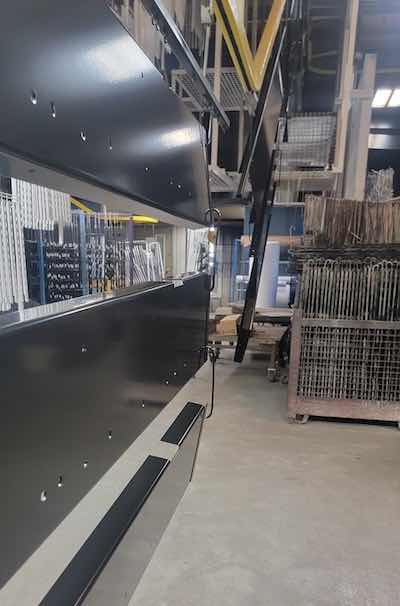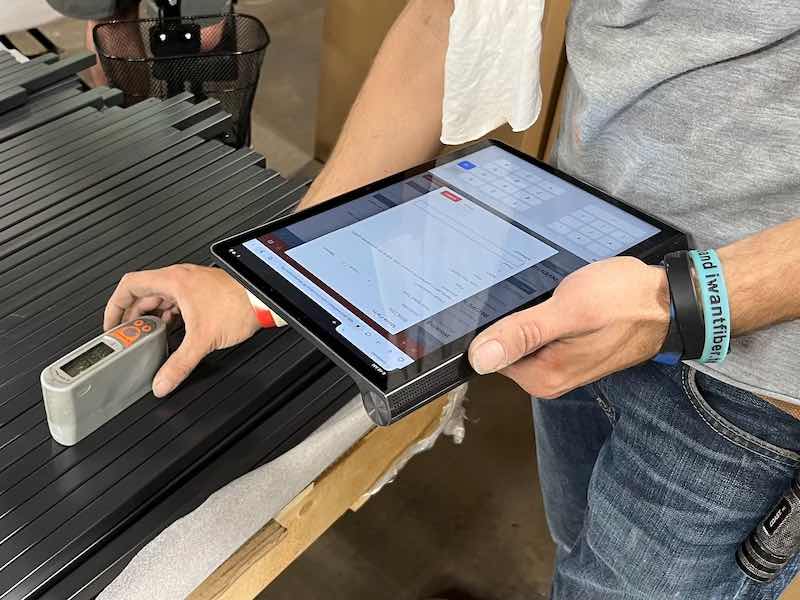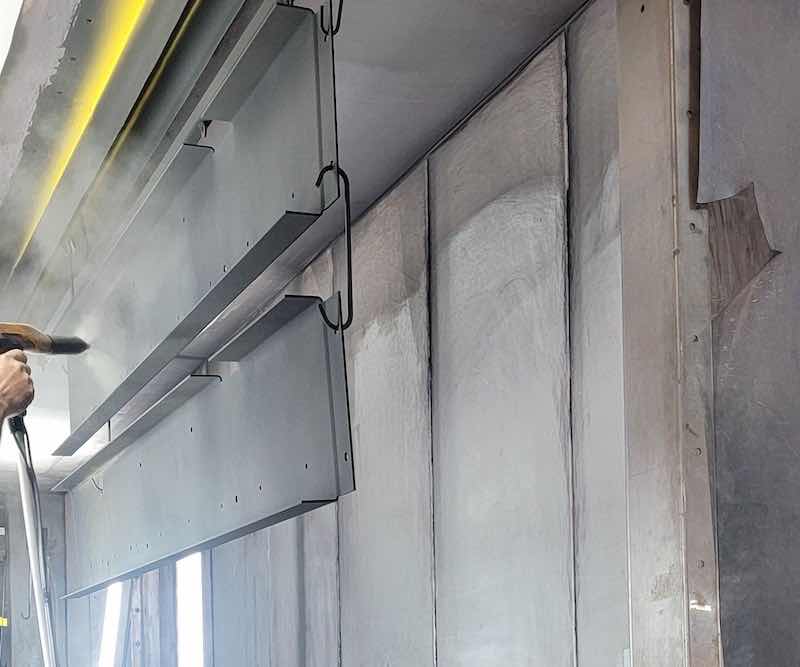Nothing can interrupt the status quo at a powder coating operation like adding automation to the mix.
 Kevin WedgeJust ask Michigan’s Kevin Wedge, General Manager of Pro Powder in South Haven, who saw a significant need to automate the facility’s coating line three years ago in order to get better quality and repeatability.
Kevin WedgeJust ask Michigan’s Kevin Wedge, General Manager of Pro Powder in South Haven, who saw a significant need to automate the facility’s coating line three years ago in order to get better quality and repeatability.
“It was a significant change in culture, attitude, and throughput,” he says. “There were challenges at every stop along the way, and we still see some from time to time today.”
But it was a necessity that Wedge felt had to be done. He had been with Pro Powder for only a few years after owner Carl Kelch had brought him in from outside the finishing industry. In fact, Wedge had come from the pharmaceutical industry and had relatively little experience in the coatings sector, but he knew an efficient operation when he saw one.
Making Operational Consistency a Habit
 Pro Powder has two conveyor lines and batch capabilities for larger parts, as well as a 3- and 6-stage wash system which allows them to customize pretreatment options to meet specifications.“Back when we had manual sprayers, and we had a couple of odds and ends here, it was just ‘hang them up on whatever rack or hook, and it will be fine,’” he says. “But when you are running something automated, you know that consistency starts at loading that line. We really had to drill it into the operators that we have to be consistent; you can’t, you know, have those one-offs like we used to because the booth will not coat the way we wanted to.”
Pro Powder has two conveyor lines and batch capabilities for larger parts, as well as a 3- and 6-stage wash system which allows them to customize pretreatment options to meet specifications.“Back when we had manual sprayers, and we had a couple of odds and ends here, it was just ‘hang them up on whatever rack or hook, and it will be fine,’” he says. “But when you are running something automated, you know that consistency starts at loading that line. We really had to drill it into the operators that we have to be consistent; you can’t, you know, have those one-offs like we used to because the booth will not coat the way we wanted to.”
Kelch founded Pro Powder in 2001, serving West Michigan, as well as accounts in Northern Indiana and Chicago. They now have two conveyor lines and batch capabilities for larger parts, as well as a 3- and 6-stage wash system which allows them to customize pretreatment options to meet specifications.
“The automated line has helped us on throughput, as well as in labor,” he says. “Before, we were doing a lot of smaller parts at high volume, up to maybe 60,000 parts per shift. It was definitely something we needed to do.”
The company employs about 25 people on the first shift depending on season and workload, but Wedge says that as organic growth continues, they hope to expand to a second shift and continue to make improvements and investments to existing equipment, facility, and processes.
Investing in IT and Infrastructure
This year, however, Pro Powder has invested time and resources in the information technology systems running the company, as well as infrastructure, hoping to allow for scalability and growth while limiting constraints on administrative staff and employee onboarding/training.
Wedge says that with just 25 employees, they only had six computers in the facility running the business, inventory, and billing aspects of the operations, and the management and employees were still doing a lot of work on paper.
“It just wasn’t in the greatest condition,” he says. “There were a lot of gaps that we were lacking in certain areas, and we were carrying some additional risk that ultimately we shouldn’t be carrying.”
First, Pro Powder made the decision to go with an outside company to manage its IT system remotely, and then they invested in additional hardware for the shop and the administration activities. Wedge says the system is much more stable than it was previously, and it is scalable if they need it to be.
Second, Wedge set out to implement enterprise resource planning software that would digitize, automate, and optimize Pro Powder’s manufacturing operations. He found the system he wanted with Steelhead Technologies, a software company located nearby in Laurium, MI, that specializes in systems for liquid and powder coating operations, as well as electroplating and anodizing shops.
Replacing Outdated ERP Software
 ProPowder utilizes Steelhead Technologies software that specializes in systems for liquid and powder coating operations, as well as electroplating and anodizing shops.“In the past, we were using dated ERP software for paperwork tickets, paper travelers, paper packing lists, and it was functional, but the base that the software was built on was just dated,” Wedge says. “We were lacking a lot of the latest and greatest features that some of the other software developers offer.”
ProPowder utilizes Steelhead Technologies software that specializes in systems for liquid and powder coating operations, as well as electroplating and anodizing shops.“In the past, we were using dated ERP software for paperwork tickets, paper travelers, paper packing lists, and it was functional, but the base that the software was built on was just dated,” Wedge says. “We were lacking a lot of the latest and greatest features that some of the other software developers offer.”
Steelhead’s software, meanwhile, offers a modern solution to managing process manufacturing in a highly customizable cloud platform that can be precisely tailored to drive data-based management in a finishing operation.
Jeff Halonen, Steelhead’s CEO, says a unique feature of its software is an all-in-one workboard that allows all employees at a facility to access targeted information applicable to their responsibilities.
But more importantly, Halonen says, the software doesn’t require a shop to significantly alter its process and procedures in order to utilize the system but rather works to fine-tune and collect data based on the way the shop is currently running its business.
‘Each Finishing Shop is So Unique’
 Jeff Halonen“A lot of software out on the market just doesn’t reflect how these finishing shops operate,” he says. “We have found that each finishing shop is so unique; they may have five manual lines or two fully automated lines, with completely different processes. Some have two dozen customers, and some have 3,800 customers, so it really is all over the place.”
Jeff Halonen“A lot of software out on the market just doesn’t reflect how these finishing shops operate,” he says. “We have found that each finishing shop is so unique; they may have five manual lines or two fully automated lines, with completely different processes. Some have two dozen customers, and some have 3,800 customers, so it really is all over the place.”
The key to making Steelhead’s plant software work was to not alter a shop’s process flow, Halonen says, but instead, give the shops a blank slate and let them build their own processes in the system.
“Finishing can be a very chaotic process at times, so we’ve put a lot of energy into replicating each shop’s workflows,” he days. “Let’s face it, at the end of the day, if the software doesn’t work for them, they’ll just go back to paper.”
Indeed, Wedge says the Steelhead software system did not drastically change what and how they did their jobs.
“It did have a direct impact on inputs and outputs from our processes,” he says. “From the moment we get a purchase order to the time we invoice — and every step along the way for each part — it gets pushed through Steelhead.”
Trove of Data and Information
 Steelhead’s software offers a modern solution to managing process manufacturing in a highly customizable cloud platform that can be precisely tailored to drive data-based management in a finishing operation.Not only has the software streamlined Pro Powder’s manufacturing processes, but Wedge now has a trove of data and information on his operations that he can mine intelligence to look for improvements.
Steelhead’s software offers a modern solution to managing process manufacturing in a highly customizable cloud platform that can be precisely tailored to drive data-based management in a finishing operation.Not only has the software streamlined Pro Powder’s manufacturing processes, but Wedge now has a trove of data and information on his operations that he can mine intelligence to look for improvements.
Previously, the shop did manual breakdowns where they looked at how many hours a job took to complete, how many operators were involved, and how much powder was used to determine overall job costs.
“It’s a very accurate data tracking and logging system,” he says. “A lot of that is done automatically. Instead of having paper, our operators now use a web-based tablet to access their work center and process orders as they’re doing it each step along the process.”
In addition, production floor operators now rely on built-in work instruction as opposed to stand-alone documents, and quality metrics are captured when needed as part of their workflow. Plus, inventory items are updated in real-time after use as opposed to using stand-alone documents.
“Our process is streamlined, which frees up time for the administrative staff,” Wedge says. “It reduces stress and the ‘unknowns’ for production staff.”
Reducing Time on Paperwork and Reports
 Halonen says that when his team was developing the Steelhead software, they were amazed at the time most shops spent on generating paperwork and reports from their processes.
Halonen says that when his team was developing the Steelhead software, they were amazed at the time most shops spent on generating paperwork and reports from their processes.
“We saw the physical act of generating reports take 10s of minutes, and sometimes hours for some shops,” he says. “To have that fully automated — sometimes at the push of a button — it puts several hours of manhours back into their pocket to be used at other places.”
More importantly, the new software system allows Wedge to respond promptly to any customer questions, even while he is working offsite.
“Being able to access our production, inventory, shipping, and invoicing directly from my phone has allowed me to respond to urgent questions at a moment’s notice,” he says. “I now have more time to engage with our accounts while monitoring production from any web-connected device.”
The IT and infrastructure improvements are just another step in Pro Powder’s goal of hopefully adding another shift to their operation while not having to add more administrative paperwork or unnecessary costs to the budget.
“If we were to bring on another shift tomorrow or the next week, obviously would have a lot of training to do, but with some of the built-in work instructions we have in our system, we can ramp up some of these new employees much quicker,” Wedge says. “The information is right there in front of them, and they can look at it as they are processing these orders. It’s great to have that type of new employee engagement and training with the information in front of them as opposed to relying on additional admin training.”
Visit https://propowder.net and https://gosteelhead.com




































